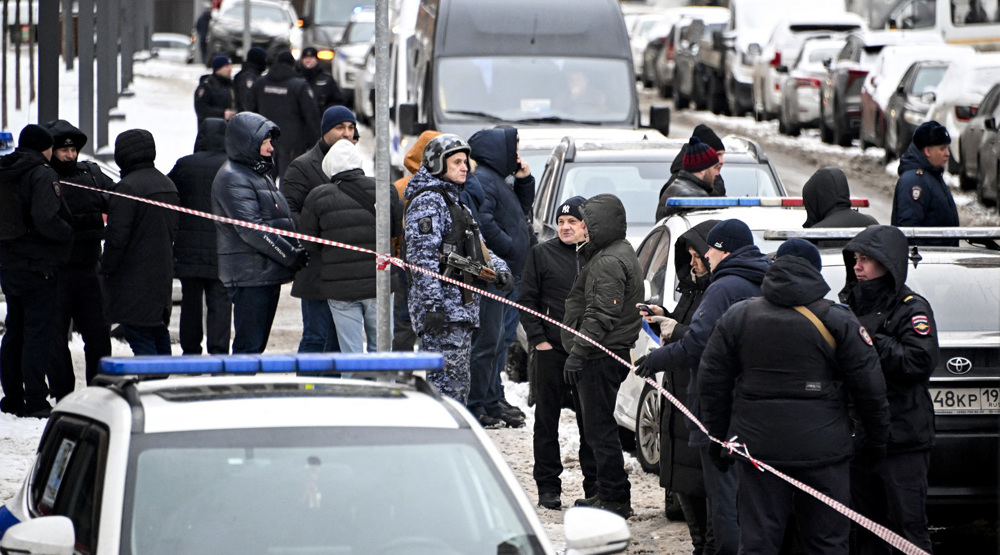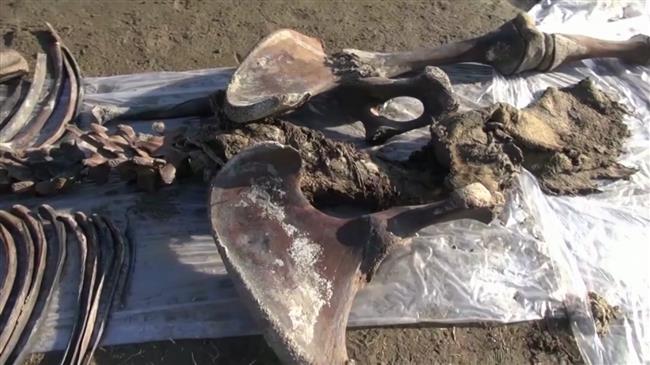Russian submarines surface, break Arctic ice during naval drills
Three Russian nuclear-powered submarines have surfaced simultaneously, breaking the Arctic ice during a naval maneuver, marking “the first time” such drills were conducted in the history of the Russian Navy.
Reporting to Russian President Vladimir Putin via videolink on Friday, Navy Commander-in-Chief Adm. Nikolai Yevmenov said the sophisticated operation was carried out by submarines that surfaced within a 300-meter radius and that the ice they broke was 1.5 meter deep.
“For the first time in the history of the Navy, three nuclear-powered missile carriers have surfaced from under the ice,” Yevmenov added, noting that the submarines surfaced “according to a single concept and plan at the appointed time in an area with a radius of 300 meters.”
The maneuver, conducted near Franz Josef Land Archipelago in the Arctic Ocean, aimed to test Russian military hardware in extreme weather conditions.
As part of the drills, a pair of MiG-31 fighters flew over the North Pole, Yevmenov added as a Defense Ministry video featured them being refueled by a tanker plane.
The video also showed three nuclear submarines that smashed through the Arctic ice next to one another.
Following Yevmenov’s report of the naval drills, Putin pointed out that the complex combat training studies carried out by the Russian Navy have shown the fleet is capable of operating in northern latitudes.
“The Arctic expedition... has no analogues in the Soviet and the modern history of Russia,” Putin said.
He further noted that the crews of submarines, military transport aircraft, fighter aircraft, as well as Arctic motorized rifle units, demonstrated enhanced combat training in the difficult polar conditions, insisting that the development of the Far North for Russia’s security must continue, Sputnik News reported.
“I order to continue Arctic expeditions and research in the Far North to help ensure Russia's security,” Putin told the navy commander.
The Kremlin is seeking to upgrade its defenses in the Arctic, which Putin has promoted as a vital region for Russian interests as climate change makes it more accessible.
The region is believed to hold up to one-quarter of the Earth’s undiscovered oil and gas and the Russian president has previously cited estimates that put the value of Arctic mineral riches at $30 trillion.
As part of its efforts to project its power over the Arctic, the Russian military has also rebuilt and expanded numerous facilities across the polar region in recent years, overhauling runways and deploying additional surveillance and air defense assets.
Russia, the US, Canada, Denmark and Norway have all been trying to assert jurisdiction over parts of the Arctic, as shrinking polar ice opens new opportunities for tapping resources and opening new shipping lanes.
The Russian military has expanded the number and the scope of its naval drills in the region amid persisting bitter tensions with member states of the US-led NATO military alliance.
Arctic transit push after Suez jam
Some reports have described Russia’s latest drills in the Arctic as efforts to promote its northern shipping route as a reliable alternative to the Suez Canal after it was blockaded earlier this week by a giant Japanese-owned container ship that ran aground, preventing vessels from passing through one of the world’s most important waterways.
Russia has seized on the Suez Canal blockage as part of a broader push by Moscow to develop the Arctic and capitalize on climate change.
Russia also redoubled efforts to promote the Arctic route after the huge Japanese tanker became wedged in the narrow Suez channel, barring nearly 200 ships passage.
A senior Russian diplomat said on Friday that the jam underscored the importance of developing the Arctic route.
"The appeal of the Northern Sea Route will grow both in the short- and long-term. It has no alternative," said Russia’s Ambassador-at-large and its point person for international Arctic cooperation, Nikolai Korchunov.
"Obviously it's necessary to think about how to efficiently manage transportation risks and develop alternative routes to the Suez Canal, first and foremost the Northern Sea Route," Korchunov added.
The Northern Sea Route is one of several Arctic shipping channels and lies within Russia's exclusive economic zone.
Russia has invested heavily to develop the route that allows ships to cut the journey to Asian ports by 15 days compared with using the Suez Canal.
Moscow is planning to use the route to export oil and gas to overseas markets while companies, including Russia's biggest LNG producer Novatek, already navigate the northern route.
Dec. 22: ‘Axis of Resistance’ operations against Israeli occupation
‘Abhorrent’: Oxfam says only 12 trucks delivered aid in North Gaza since Oct.
VIDEO | Leader receives religious eulogists on Hazrat Fatima birth anniv.
Pope Francis slams Israel’s ‘machine-gunning’ of Gaza children
US hostage-taking of Iranian nationals violation of intl. law: Deputy FM
VIDEO | Carol Singers for Palestine on London’s Parliament Square
Ansarullah says ‘Israeli terrorists’ incapable of confronting Yemen, warns of secret weapons
VIDEO | Yemenis praise the military for its successful operations against Israel












 This makes it easy to access the Press TV website
This makes it easy to access the Press TV website